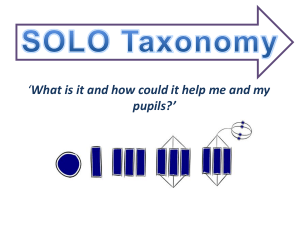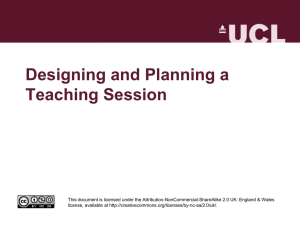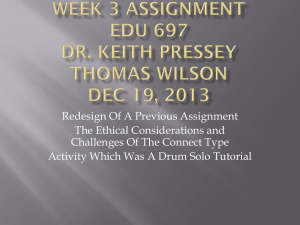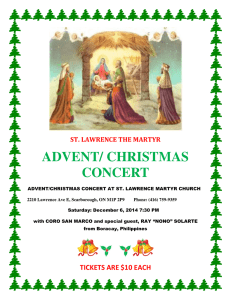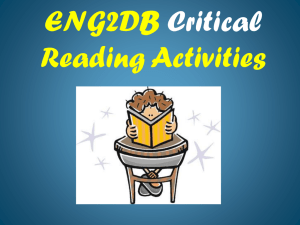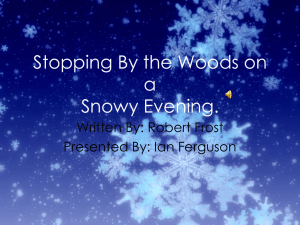Going SOLO Jul09
advertisement
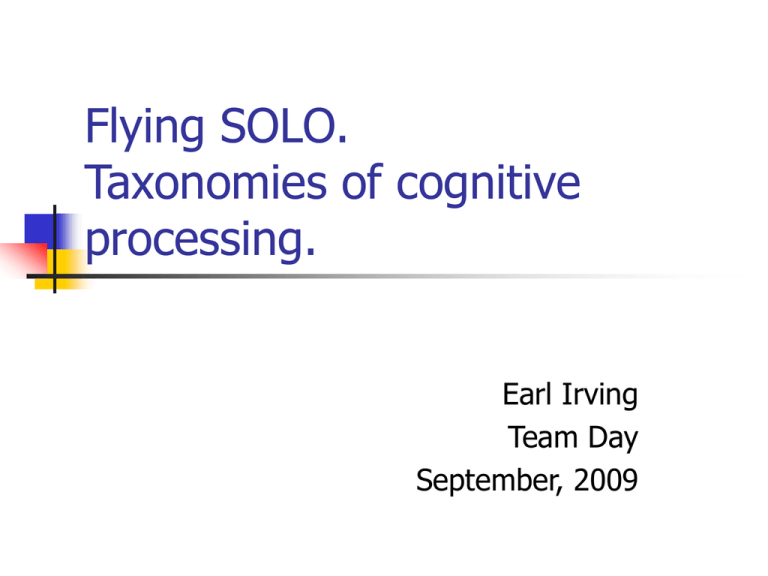
Flying SOLO. Taxonomies of cognitive processing. Earl Irving Team Day September, 2009 Overview Ways of describing questioning & thinking --> cognitive taxonomies Bloom et al SOLO (Collis & Biggs) Examples Summary The questions teachers ask. 80% of teacher questions require low order thinking skills Recall or remembering Knowledge Simple handling of a restricted set of ideas, data, knowledge Goal is to ask more higher level questions – make ‘em think!! Back to Questioning Taxonomies of thinking Need a way to classify categories of thinking (cognitive processing) in increasing degrees of complexity Bloom et al (1956). Cognitive, affective and psychomotor Has dominated approaches to assessment / questioning Supposed to be hierarchical, but isn’t Bloom’s Taxonomy (1956) appraise, evaluate, justify combine, rearrange, rewrite critique, discriminate, relate demonstrate, modify, solve explain, infer, summarise list, label, name, state SOLO Structure of Observed Learning Outcomes (Collis & Biggs, 1982) Analysed structure of student responses to questions Four (five) categories at two levels: Surface: Unistructural, and Multistructural Deep: Relational, and Extended Abstract Elements of SOLO Student R Response X Irrelevant, not given • Relevant, given o Relevant, not given Unistructural Uses one given piece of information. Student presents simple and obvious information What was the name of that movie? What year was the Treaty of Waitangi signed? How many beans make five? Sees a part of the house in isolation. Identifies a window, or the roof. Cannot see connections or significance of the parts Multistructural Uses 2 or more facts, which are not necessarily related to each other Name three characters in the movie. Give 2 reasons why it is sensible to drive on the left. Can see parts of the house separately, but no sense of the whole. Disorganised collection of ideas around the issue Relational Uses 2 or more pieces of information, and makes connections among them Sees the significance of the parts to the whole Compare and contrast meiosis and mitosis Explain the causes of … Students able to appreciate the significance of parts in relation to the whole Can put the whole house together Work starts to move between the facts and theory Extended abstract Makes connections not only with the given subject material, but also beyond it Why do fairy tales use animals to portray human characteristics? Find a formula to describe the pattern –1, 1, 3, 5, … Students make connections not just with the given subject area but beyond it; apply, generalise and transfer principles and ideas underlying the specific Sees the community around the house Another SOLO schema Learning: deep and surface approaches STOPPING BY WOODS ON A SNOWY EVENING by Robert Frost Whose woods these are I think I know. His house is in the village though; He will not see me stopping here To watch his woods fill up with snow. My little horse must think it queer To stop without a farmhouse near Between the woods and frozen lake The darkest evening of the year. He gives his harness bells a shake To ask if there is some mistake. The only other sound’s a sweep Of easy wind and downy flake. The woods are lovely, dark and deep, But I have promises to keep, And miles to go before I sleep, And miles to go before I sleep. Bloom Questions for Frost Knowledge Where does the owner of the woods have his house? _____________________________________ Comprehension Why do the horse’s bells shake? a. The horse is shaking off the snow b. The horse is shivering with the cold c. The horse is ready to move on d. The horse is being blown by the wind Application Write a poem that uses the same rhyme scheme as stanza ________________________________________________ ________________________________________________ ________________________________________________ Bloom Questions for Frost Analysis Janet thinks the poem is set at Christmas time. Find two pieces of evidence in the poem she would use to support her argument. a) ________________________________________________ b) ________________________________________________ Synthesis Frost suggests that people need to choose between responsibility and personal needs. What would happen to society if everyone chose only personal needs? ________________________________________________ ________________________________________________ ________________________________________________ Evaluate Is this poem a classic? Support your opinion with reference to the quality of its message and style. ________________________________________________ ________________________________________________ ________________________________________________ SOLO Surface Questions for Frost Unistructural Why does the horse shake the harness bells? _____________________________________________ Multistructural What two phrases suggest that the poem could be set at Christmas? a) ___________________________________________ b) ___________________________________________ SOLO Deep Questions for Frost Relational Why does the horse think it is unusual to stop by the woods? a) It is the darkest evening of the year b) The woods are filling up with snow c) There is no sound other than the soft wind d) There are no houses near the woods Extended Abstract What is the main message of the poem? a. Nature is especially beautiful in winter b. People would like to avoid their responsibilities if they could c. People and animals don’t like to be out in the dark and cold d. Travelling at winter time is disturbing Strategy for Writing Deeper Questions Take a Unistructural Question and require a list of 3 things Multistructural Question Put the list of things into the question and ask what they have in common Relational Question Decide what the individual relationship is representative of – what class of event, personality, situation, rule, etc. does this relationship in this context connect to? Generate list of possible wrong answers to go with correct answer to create M-C question that asks for the rule Extended Abstract Question Sample Deeper Questions: Goldilocks & Three Bears Multi-structural List 3 aspects of the story that suggest that the story is not a real life situation. Bears don’t live in houses 2. Bears don’t sleep in beds 3. Bears don’t eat cooked food Relational 1. What does the fact that the bears behave in a human-type fashion (e.g., they live in houses, eat cooked food, and sleep in beds) tell us about the kind of story Goldilocks is? It’s a nursery tale b) It’s a newspaper story c) It’s a biography d) It’s an encyclopaedia entry Extended Abstract a) Why do nursery tales allow wild animals to act in human fashion? a) b) c) d) humans anthropomorphise in order to reveal more about human nature in a psychologically safe way to show the oneness of nature and humanity by having wild beasts behave like humans to entertain children who easily believe that they can communicate with imaginary and wild creatures to give children courage to face the mysteries and dangers of powerful nature and scary adult life Mathematics example Houses Sticks 1 5 2 3 9 __ How many sticks are needed for 3 houses? UNI How many sticks are there for 5 houses? ______ MULTI If 52 houses require 209 sticks, how many sticks do you need to be able to make 53 houses? ______ RELATIONAL Make up a rule to count how many sticks are needed for any number of houses. EXTENDED ABSTRACT Achievement Objective: Recognise & Use Factors in a Variety of Practical Settings UNISTRUCTURAL Complete (x +2)(x+2) = x2 +4x + ___ MULTISTRUCTURAL Factorise x2 + 2x – 8. RELATIONAL The area of a rectangle in square centimetres is represented by the expression x2 + 2x – 8. The length of the rectangle is x + 4 centimetres. What is an expression for the width of the rectangle in centimetres? EXTENDED ABSTRACT When the final term of a quadratic is a negative value, what is the pattern of operations within the two factors? (A) both addition subtraction (B) both subtraction C) addition & Changing SOLO Levels: Technology (MES) Achievement Objective: Basic Skills in Using Ordinary Hand Tools in Manufacturing. Changing SOLO Levels: Technology (MES) UNISTRUCTURAL Name Tool A. ____________ MULTISTRUCTURAL Identify the primary function of Tools D and B. D _________ B __________ RELATIONAL Explain how Tool C could be used in making a metal sink. ________________________________________ EXTENDED ABSTRACT What might be the best reason for an engineer keeping hand tools for metal work? (a) They would make a valuable historical collection (b) They are more powerful than electric tools (c) They can be used when the power goes off (d) They are less likely to break or wear out Summary SOLO is a hierarchic taxonomy—increasing quantity & quality of thought SOLO is powerful in creating variety in the difficulty of curriculum & cognitive challenge SOLO level depends on assumed ‘Givens’— the prior knowledge & tools available to students Both Surface & Deep questions are needed, not one is better than the other Contact Earl Irving Team Solutions University of Auckland 623 8899 Extn 48419 e.irving@auckland.ac.nz
